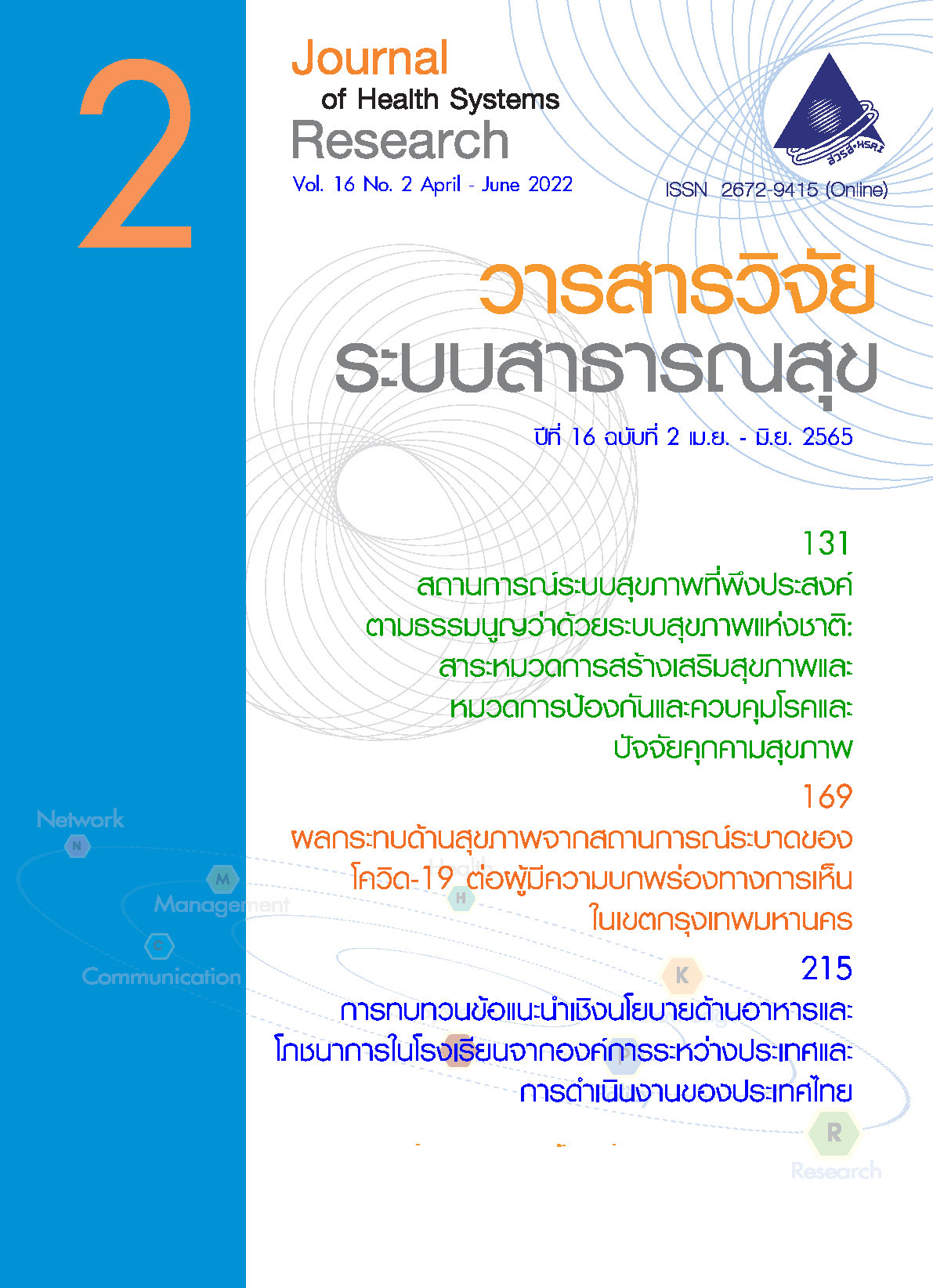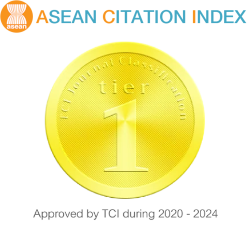Factors Associated with Contribution Payment among Insured Workers under Social Security Act’s Article 40: the Case of Sickness Benefit
Keywords:
insured workers under Article 40, informal employment, social security, benefit eligibility, sickness benefitAbstract
This analytical observational study aimed to investigate relationships between factors and contribution payments for the sickness benefit among insured workers under the Social Security Act’s Article 40 who had been registered for 3–5 months on December 31, 2019. The data used for the analysis came from 53,556 insured workers who registered with Article 40 between August – September 2019. Descriptive statistics and binary logistic regression were used to describe the overall data and investigate the relationships among the studied factors.
The analysis showed that age, occupation and registration channels were significantly associated with the contribution payments to fulfill the sickness benefit, while sex, income, contribution amount and benefit options were not. Those aged 25–34 years, in service works, working in machinery factories, and registration channel through a community based - social security agent had an increased chance of losing the sickness benefit compared to their counterparts. These results suggest strategic targeting the insured workers under Article 40 to ensure access to continuous sickness benefit of the social security system.
References
Social Security Act B.E. 2533 (1990). (Aug. 11, 1990) (in Thai)
Statistics and Actuary Unit. Number of monthly contribution payments among insured workers under Article 40. October 2020. Research and Development Division, Social Security Office. (in Thai)
Kloyiam S. Why insured persons under Social Security Act’s Article 40 miss contribution payment: a qualitative study [Manuscript submitted for publication]. Development and Research Division, Social Security Office, Ministry of Labour, Thailand. 2021. (in Thai)
Chanduaywit W, Chonpitakwong B. Informal workers: a case study of roadside shops. Thailand Development Research Institute (TDRI). 2020. [Internet]. [cited 2021 Mar 25]. Available from: https://tdri.or.th/2020/03/informal-labor-hawker-high-way/. (in Thai)
National Statistical Office. The informal employment survey 2020. Bangkok: Ministry of Digital Economy and Society; 2020. (in Thai)
Louis D. Enoff, Roddy McKinnon. Social security contribution collection and compliance: Improving governance to extend social protection. International Social Security Review. 2011;64(4).
Atnafu DD, Tilahun H, Alemu YM. Community-based health insurance and healthcare service utilisation, North-West, Ethiopia: a comparative, cross-sectional study. BMJ Open. 2018 Aug 8;8(8):e019613. doi: 10.1136/bmjopen-2017-019613.
Ghimire P, Sapkota VP, Poudyal AK. Factors Associated with Enrolment of Households in Nepal’s National Health Insurance Program. Int J Health Policy Manag. 2019 Nov 1;8(11):636-45. doi: 10.15171/ijhpm.2019.54.
Iqbal M, Chowdhury AH, Mahmood SS, Mia MN, Hanifi SMA, Bhuiya A. Socioeconomic and programmatic determinants of renewal of membership in a voluntary micro health insurance scheme: evidence from Chakaria, Bangladesh. Glob Health Action. 2017;10(1):1287398. doi:10.1080/16549716.2017.1287398.
Mahmood SS, Hanifi SMA, Mia MN, Chowdhury AH, Rahman M, Iqbal M, et al. Who enrols in voluntary micro health insurance schemes in low-resource settings? Experience from a rural area in Bangladesh. Glob Health Action. 2018;11(1):1525039. doi:10.1080/16549716.2018.1525039.
Mirach TH, Demissie GD, Biks GA. Determinants of community-based health insurance implementation in west Gojjam zone, Northwest Ethiopia: a community based cross sectional study design. BMC Health Serv Res. 2019;19(1):544. doi:10.1186/s12913-019-4363-z.
Oraro T, Wyss K. How does membership in local savings groups influence the determinants of national health insurance demand? A cross-sectional study in Kisumu, Kenya. Int J Equity Health. 2018;17(1):170. doi: 10.1186/s12939-018-0889-7.
Otieno PO, Wambiya EOA, Mohamed SF, Donfouet HPP, Mutua MK. Prevalence and factors associated with health insurance coverage in resource-poor urban settings in Nairobi, Kenya: a cross-sectional study. BMJ Open. 2019;9(12):e031543. doi: 10.1136/bmjopen-2019-031543.
Preecha R, Lakkanawanit P. Decision – making of informal workers in Muang District, Nakhon Si Thammarat province to save money in the National Savings Fund. Veridian E-Journal, Silpakorn University. 2018;11(2): 3261-79. (in Thai)
Seddoh A, Sataru F. Mundane. Demographic characteristics as predictors of enrolment onto the National Health Insurance Scheme in two districts of Ghana. BMC Health Serv Res. 2018;18(1):330. doi: 10.1186/s12913-018-3155-1.
Thamviriyavong P. The attitude towards the persistence of the voluntary insured persons (Article 40) of Social Security Office, Pathumthani province. Dusit Thani College Journal. 2018;12(1):296-314. (in Thai)
Kloyiam S, Suwannapoom N, Srirattanawong P. Conceptual framework of empirical factors related to voluntary health and social insurance enrolment: an implication for Thai Social Security Act, Article 40. Journal of Health Systems Research. 2021;15(2):250-71.
Bujang MA, Sa’at N, Sidik TMITAB, Joo LC. Sample size. Guidelines for logistic regression from observational studies with large population: emphasis on the accuracy between statistics and parameters based on real life clinical data. Malays J Med Sci. 2018;25(4):122-30. doi:10.21315/mjms2018.25.4.12.
Hosmer DW, Lemeshow S. Applied logistic regression. 2nd ed. New York: John Wiley & Sons Inc; 2000. [Internet]. [cited 2021 Jan 11]. Available from: http://resource.heartonline.cn/20150528/1_3kOQSTg.pdf.
Midi H, Sarkar SK, Rana S. Collinearity diagnostics of binary logistic regression model. Journal of Interdisciplinary Mathematics. 2010;13(3):253–67. doi:10.1080/09720502.2010.10700699.
Akoglu, H. User’s guide to correlation coefficients. Turkish Journal of Emergency Medicine. 2018;18(3):91–3. doi:10.1016/j.tjem.2018.08.001.
Plantenga, J. The life course and the system of social security: rethinking incentives, solidarity and risks. European Journal of Social Security. 2005:7(4):301–12.doi:10.1177/138826270500700402.
Hendrik P. Van Dalen. Work, savings, and social security in a life course perspective. Population issues: an interdisciplinary focus. New York: Kluwer Academic/Plenum Publishers; 1999. p. 123-57. doi: 10.1007/978-94-011-4389-9_5.
Wongchaya P. Acknowledgment and decision making of self-employed beneficiaries under Section 40 of the Social Security Act, Social Security Office of Phrae province. (master’s thesis). Bangkok: Faculty of Social Administration, Thammasat University; 2015. (in Thai)
Nshakira-Rukundo E, Mussa EC, Nshakira N, Gerber N, von Braun J. Determinants of enrolment and renewing of community-based health insurance in households with under-5 children in rural South-Western Uganda. Int J Health Policy Manag. 2019;8(10):593-606. doi:10.15171/ijhpm.2019.49.
Kisiizi Hospital. Kisiizi Health Insurance Scheme [Internet]. [cited 2021 Mar 25]. Available from: http://www.kisiizihospital.org.ug/wp-content/uploadedfiles/2019/06/KISIIZI-HOSPITAL-HEALTH-INSURANCE-SCHEME-article-08-2018.pdf.
Office of Insurance Commission. Handbook for insurance agencies: insurance agency certification course. Bangkok: Office of Insurance Commission; 2013. (in Thai)
Life Insurance Act B.E. 2535 (1992). (Apr 4, 1992). (in Thai)
Downloads
Published
How to Cite
Issue
Section
License
Copyright (c) 2025 Journal of Health Systems Research

This work is licensed under a Creative Commons Attribution-NonCommercial-NoDerivatives 4.0 International License.
Journal of Health Systems Research is licensed under a Creative Commons Attribution-NonCommercial-NoDerivatives 4.0 International (CC BY-NC-ND 4.0) license, unless otherwise stated.




